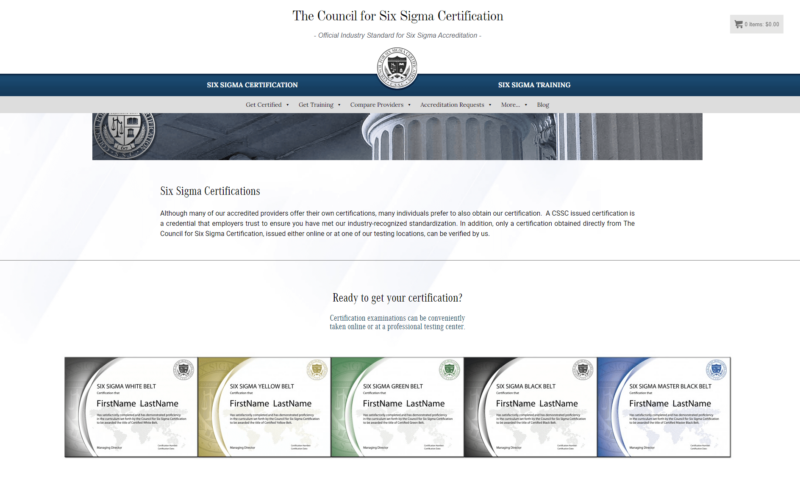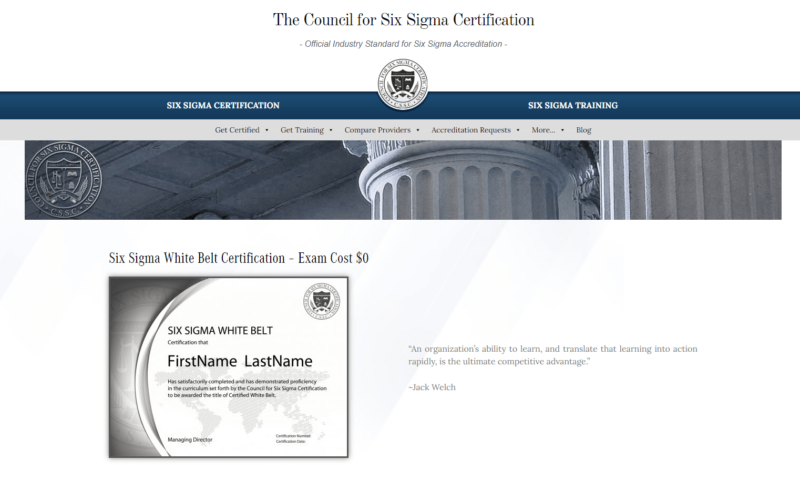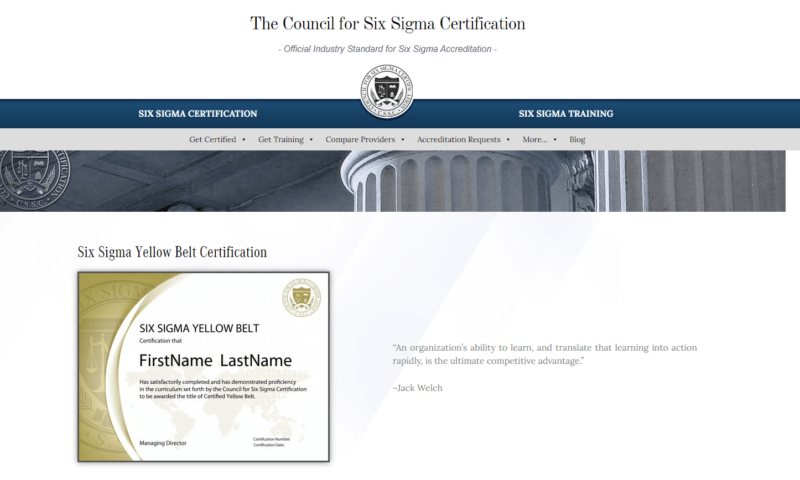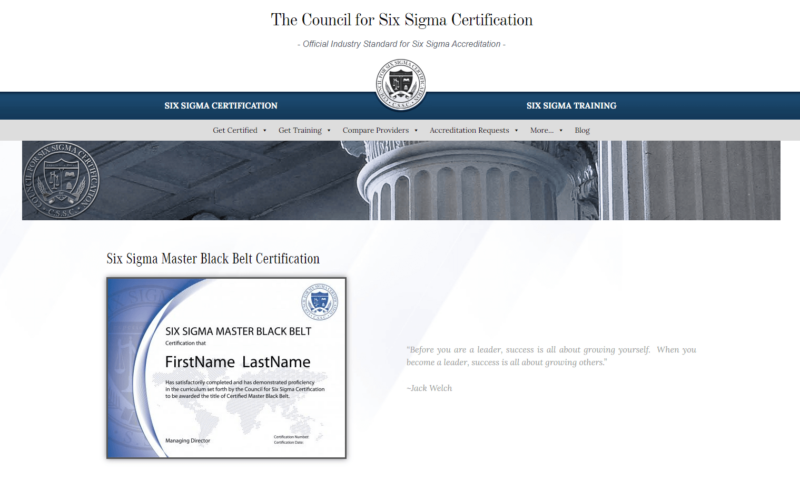Manufacturing industries laud the Six Sigma methodology and Six Sigma tools for their ability to help companies reduce product variances and defects and improve processes. You can learn about these metrics, which can be tracked in the best project management software, through the various Six Sigma belt levels. We’ll break those levels down in this guide.
Below, we’ll explain Six Sigma certification, the five levels of certification and what each Six Sigma belt certification allows you to work on during Six Sigma projects. We’ll also cover certification costs and benefits, and briefly touch on what you can expect to earn. We know you’re eager to learn, so let’s get started.
What Is the Six Sigma Certification?
Six Sigma is a certification that shows prospective and current employers that you have the knowledge and know-how to use data and facts to apply Six Sigma principles to improve business operations and eliminate product variations and defects during production.
What Are the Six Sigma Belt Levels? Order & Explanation
The Six Sigma belt levels are White Belt, Yellow Belt, Green Belt, Black Belt and Master Black Belt. If you’re ready to boost your project management career and manage Six Sigma projects, you’ll need to prepare yourself to undergo rigorous Six Sigma training. Below, we’ll examine the different Six Sigma certification levels.

Six Sigma White Belt
The Six Sigma White Belt is a free, entry-level certification that anyone can take. There are no prerequisites. You’ll learn about creating customer value, the Deming wheel and the basics of Six Sigma. This certification will open your eyes to the world of Six Sigma and could help you land roles on problem-solving teams.
Six Sigma Yellow Belt
Those with the Six Sigma Yellow Belt can prove they have the skills to be part of a project team. The Yellow Belt is ideal for those who know about the Deming wheel and who already make decisions regarding project improvements. However, it does not mean you can lead projects. There are no prerequisites for this belt certification; if you feel ready to take the exam, you can.
Six Sigma Green Belt
The Six Sigma Green Belt certification is for those who wish to demonstrate their data analysis and problem-solving skills. It also shows they know how to use the define, measure, analyze, improve and control (DMAIC) method. Applicants must prove they have three years of experience as a paid, full-time Six Sigma team member to sit for the exam.
Those with the Green Belt certification have another choice to make. If they’re happy staying in their current lane and don’t wish to progress to the Black Belt, they can instead seek the Green Belt II certification, which further showcases their ability to run project processes and small, well-defined projects efficiently.
Six Sigma Black Belt
The Six Sigma Black Belt is for individuals who want to show the world that they thoroughly understand Six Sigma processes and principles and have strong leadership skills. Black Belt holders also know how to identify non-value-adding processes in projects and remove them, can designate team members to specific roles and understand basic Lean principles.
Like the Green Belt, the Black Belt has different levels of certification: the standard Black Belt, Black Belt II and Black Belt III. Black Belt II shows that managers are expert team leaders and that individuals have exceptional knowledge of DMAIC and Lean concepts. Black III certifies that managers can successfully use the define, measure, analyze, design and verify (DMADV) method during projects.
Six Sigma Master Black Belt
Master Black Belts are experts who know Six Sigma from top to bottom. They are expected to know and understand all Six Sigma principles and philosophies, including DMADV and DMAIC; be outstanding leaders; and incorporate Lean enterprise concepts to help reduce waste, cut costs and increase customer value.
Six Sigma Certification Career Benefits
As you can imagine, obtaining a certification can do wonders for your self-confidence and career. Below are some of the main benefits of acquiring Six Sigma certifications.
- Enhanced recognition: Holding any of the Six Sigma certifications will help you earn your peers’ respect. Listing the certifications on platforms such as LinkedIn will also help your profile stand out to hiring managers.
- Increased knowledge: The time and effort you put into studying will boost your knowledge and confidence.
- Better job prospects: Obtaining certifications will open the door to many job opportunities.
- Increased earning potential: With a certification in hand, your earning potential will increase. Salaries in the U.S. for White Belts to Master Black Belts range from $42,000 to $135,000 annually. 1
How Much Does the Six Sigma Belts Certification Cost?
Prices for Six Sigma certification will vary depending on the education partner you choose and whether you just need to sit for the exam or require study materials. The prices below are from The Council For Six Sigma Certification, which is considered the gold standard for these certifications.
 White Belt: The White Belt is completely free.
White Belt: The White Belt is completely free. Yellow Belt: Prices for this certification range from $99 to $349, depending on whether you just need to take the test or obtain self-study guides.
Yellow Belt: Prices for this certification range from $99 to $349, depending on whether you just need to take the test or obtain self-study guides. Green Belt: Prices range from $159 to $349, depending on whether you’re only taking the test or need study guides.
Green Belt: Prices range from $159 to $349, depending on whether you’re only taking the test or need study guides. Black Belt: The cost of the Black Belt Certification ranges from $229 to $349. The pricing depends on whether you need study materials or are just taking the exam.
Black Belt: The cost of the Black Belt Certification ranges from $229 to $349. The pricing depends on whether you need study materials or are just taking the exam. Master Black Belt: The Master Black Belt examination is the most expensive, at $665.
Master Black Belt: The Master Black Belt examination is the most expensive, at $665.
What Is the Lean Six Sigma Certification?
Lean Six Sigma certifications are similar to Six Sigma certifications, but they are not the same. There’s a separate set of Lean Six Sigma certifications. Six Sigma focuses on using statistical data to identify and eliminate product variables and defects. Lean Six Sigma uses data and facts to help prevent product defects, reduce costs and eliminate waste.

Lean Six Sigma belt entail separate certifications.
Final Thoughts
If you’re a member of a project team looking to advance your career, increase your job prospects and earn a better salary, Six Sigma certification could be for you. Becoming certified means more than just landing a better job or earning a larger paycheck. Individuals who complete the training will enhance their knowledge, grow their confidence and earn respect.
Do you plan to become Six Sigma certified? Which belt level interests you the most? Is there anything else you’d like to learn about Six Sigma? Let us know in the comments. Thanks for reading.
FAQ: Six Sigma Belt Levels
-
The Six Sigma belt levels are White Belt, Yellow Belt, Green Belt, Black Belt and Master Black Belt.
-
There are five levels in Six Sigma, including White Belt, Yellow Belt, Green Belt, Black Belt and Master Black Belt. It’s also worth mentioning the Green Belt II and the Black Belt II and III certifications.
-
Yes, you can skip the Yellow Belt, as there are no prerequisites for the Green Belt.
-
Yes, the Six Sigma Green Belt is worth obtaining, especially if you want to prove your statistical and data-gathering knowledge and problem-solving skills.
{“@context”:”https:\/\/schema.org”,”@type”:”FAQPage”,”mainEntity”:[{“@type”:”Question”,”name”:”What Are the Levels of Six Sigma Belts? “,”acceptedAnswer”:{“@type”:”Answer”,”text”:”
The Six Sigma belt levels are White Belt, Yellow Belt, Green Belt, Black Belt and Master Black Belt.\n”}},{“@type”:”Question”,”name”:”How Many Levels Are There in Six Sigma?”,”acceptedAnswer”:{“@type”:”Answer”,”text”:”
There are five levels in Six Sigma, including White Belt, Yellow Belt, Green Belt, Black Belt and Master Black Belt. It\u2019s also worth mentioning the Green Belt II and the Black Belt II and III certifications.\n”}},{“@type”:”Question”,”name”:”Can You Skip Yellow Belt in Six Sigma?”,”acceptedAnswer”:{“@type”:”Answer”,”text”:”
Yes, you can skip the Yellow Belt, as there are no prerequisites for the Green Belt.\u00a0\n”}},{“@type”:”Question”,”name”:”Is the Six Sigma Green Belt Worth It? “,”acceptedAnswer”:{“@type”:”Answer”,”text”:”
Yes, the Six Sigma Green Belt is worth obtaining, especially if you want to prove your statistical and data-gathering knowledge and problem-solving skills.\n”}}]}
Sources:
The post Six Sigma Belt Levels: Order, Roles, Salary & Benefits Explained in 2024 appeared first on Cloudwards.






